by Editor | Mar 18, 2013 | Food
By Elena del Valle
Photos by Gary Cox
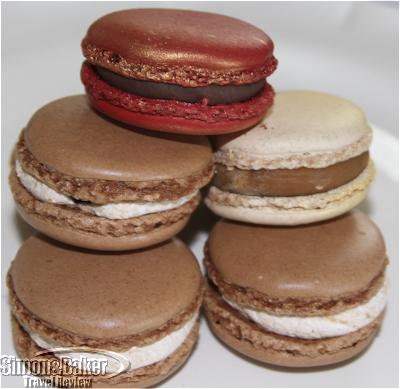
Some of our favorite macaron flavors for the holidays
For several years we have been fans of the Pierre Herme shop, specifically the macarons, on rue Napoleon in the Latin Quarter of Paris. On our most recent visit to the French capital, we made our usual stop at the shop and also visited, for the first time, its larger sister shop on the rue de Vaugirard in the fifteenth arrondisement.
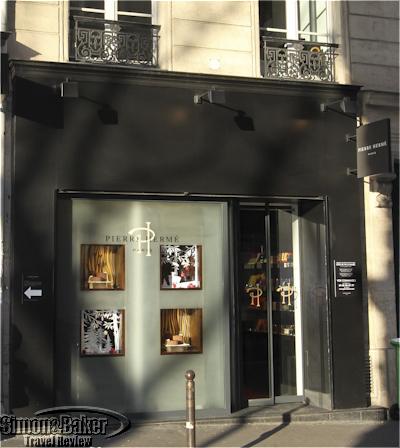
An exterior view of the Pierre Herme shop on rue Napoleon in the Latin Quarter

The special Jardin Collection
We had our favorite macaron flavors of Ispahan made with rose, litchi and raspberry, Truffe Blanche et Noisette (white truffel and hazelnut), Infiniment Caramel (caramel and salted butter), Rose, and Chocolate and Foie Gras. We also sampled the special Jardin Collection, a box of 12 macarons only available once a year with a roundup of the monthly Jardin Collection flavors. There was one of each of the 2012 flavors: Jardin Marin made with green tea, chaterelle mushroom and lemon; Jardin du Pardis made with aniseed and saffron; Jardin d’Ete made with lemon and caramelized fennel; Jardin Oriental made with orange blossom, rose and ginger; Jardin Parfume made with rose and jasmin; Jardin d’Eden made with vanilla and basil; Jardin Sauvage made with chocolate and lime; and Jardin d’Antan made with violet and aniseed. There were two each of Jardin Enchante made with lime, raspberry and espelette pepper and Jardin Secret made with rose, vanilla and cloves.
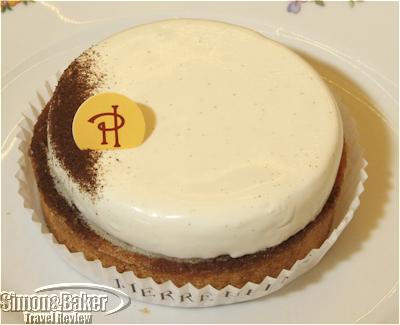
The vanilla tart
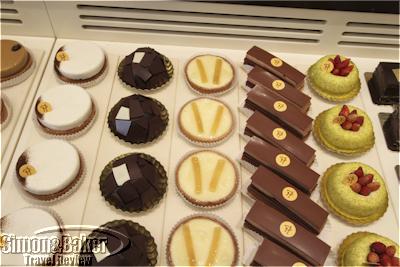
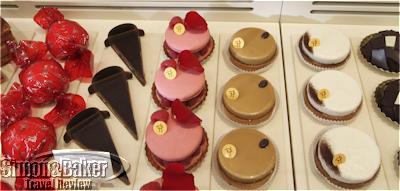
Pastries at the Latin Quarter shop
While macarons are the reason we go to the Latin Quarter store every time we go there we are tempted by seasonal specials, chocolates and pastries. This time we decided to expand our tasting selection. We sampled a lemon tart, reminiscent of key lime pie with a tart finish, a vanilla tart, sweet with distinctive and extra rich vanilla bean flavors, and chocolates. The best selling items in the Latin Quarter shop? Ispahan cake (a long time favorite), Tarte Infiniment Vanille (the one we sampled), 2000 feuilles and of course macarons and chocolates, according to a company spokesperson.
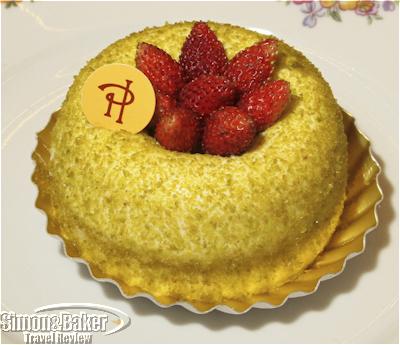
A lime with fresh strawberries dessert
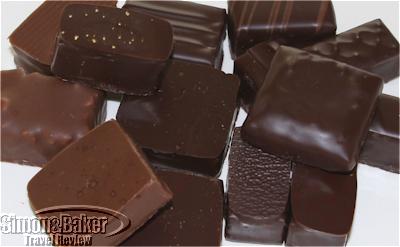
We sampled Pierre Herme chocolates made at the Manufacture Pierre Hermé Paris in Wittenheim, Alsace
On previous visits to the shop the staff had offered us samples of their chocolates. When we tried to buy the ones we had sampled we discovered it was only possible to buy a box with a variety of flavors. Disappointed we desisted. This time we threw caution to the wind. We acquired two boxes of 14 delicious bon bons, made mostly of 64 percent dark chocolate from Mexican cocoa (45 percent for the three milk chocolate ones), in mid December 2012. The Pierre Herme chocolates were made at the Manufacture Pierre Hermé Paris in Wittenheim, Alsace. The brown square box with a red center and a red leather string around it weighed 120 grams and expired January 3, 2013. With all the tempting foods available during the trip we missed the expiration date for one of the boxes. We sampled the chocolates in late January and they were still good. Our expanded tasting was a success.
While Pierre Herme macarons are sold elsewhere in Paris we prefer, whenever possible, to visit the company shops. In our experience they offer greater character and more merchandise choices. We remain fans of the original shop, our favorite of the two for sheer cozy ambiance and geographic convenience, and are now new fans of the rue de Vaugirard boutique. The two shops are on our list of city favorites: Pierre Hermé Paris, 72 rue Bonaparte 75006 Paris, France, +33 (0) 1 43 54 47 77, and Pierre Hermé Paris, 185 rue de Vaugirard 75015 Paris, France, +33 (0) 1 77 37 20 96, www.pierreherme.com, contact.boutiques@pierreherme.com.
by Editor | Feb 25, 2013 | Food
By Elena del Valle
Photos by Gary Cox
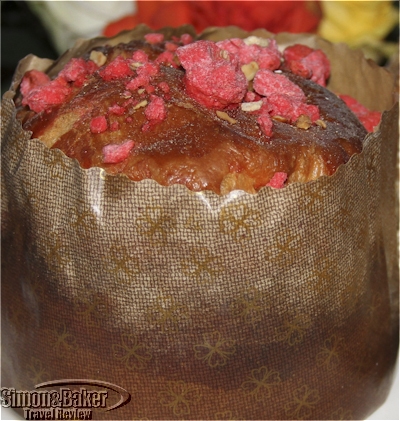
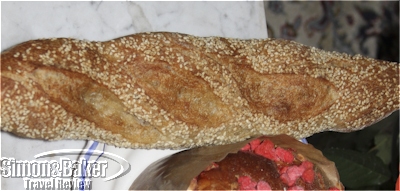
A praline brioche and a sesame baguette
On our most recent trip to Paris, France we discovered a new bakery, well two new bakeries owned by the same person and company. With so many bakeries in the City of Lights what makes these special? The bread. To be precise the bread, the brioche praline and the bite size chocolate (pistachio and regular) financier cakes. The taste of the baked goods we sampled was outstanding. We later found out the baked goods were made fresh daily with no artificial ingredients, additives or colorants and “all bread is prepared, hand kneaded and baked in-house at each and every Kayser company bakery,” according to a company spokesperson.
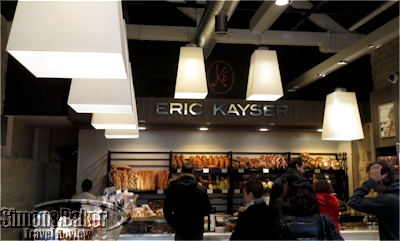
The Maison Kayser shop in Bercy Village
We first went to Maison Kayser Bercy Village (41, cour Saint-Emilion, 75012 Bercy Village, +33 01 43 46 08 89) in the twelfth arrondissement, a bakery with restaurant seating indoors and a shaded outdoor terrace. Since it was winter the outdoor area was vacant but the indoor dining room was popular. We arrived before lunch on a Sunday and were glad we had a reserved table. A steady flow of customers filled the bakery while hungry patrons claimed tables in the dining room. By the time we left it was getting crowded.
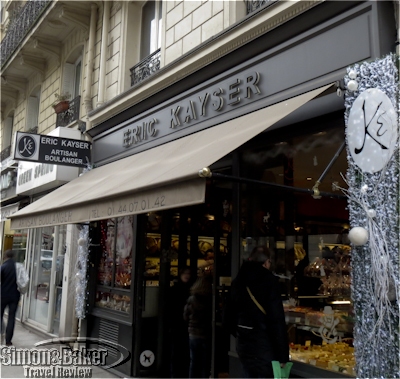
The shop entrance on rue Monge in the Latin Quarter
The following week, we made our way to the shop on Rue Monge (8, rue Monge, 75008, Paris, +33 01 44 07 01 42) in the Latin Quarter, one of twenty-one shops in Paris and 100 overall, in search of more good bread nearer our accommodations. While there the brioche praline, a large brioche topped with bright red sticky bits (we later found some of the sweet and crunchy substance within the brioche), peaked our interest enough to carry it home along with a 200 gram bag of chocolate financiers. We had fallen in love with the bite size cakes made with almond flower and brown butter when we sampled them the previous Sunday at Bercy Village.
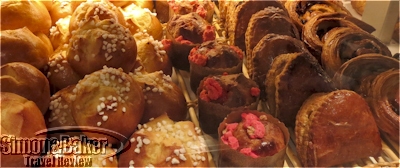
It was difficult to choose
As soon as we arrived home we sliced the bread and brioche, wanting to taste them while they were fresh. The bread, with seeds, was crunchy with a rewarding rich flavor. In the brioche, we were surprised to discover a perfect combination of flavor and texture. It was airy with a mild flavor while the praline filing had just the right amount of sweetness and crunch to make sure there was praline on every slice and pile on extra sometimes.
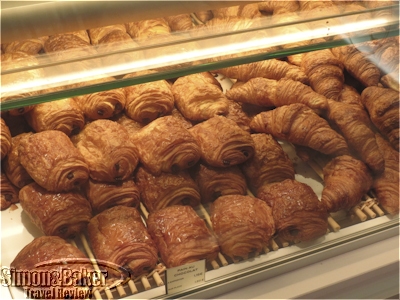
Classic French pastries for sale at Bercy Village
Eric Kayser, the bakery chain’s namesake and the son, grandson and great grandson of bakers, is said to have known from the time he was four years old that he wanted to become a baker and travel. “Being a food lover, manual and curious, I loved to touch the dough, taste the leaven and see how this living element developed during fermentation,” he said by email.
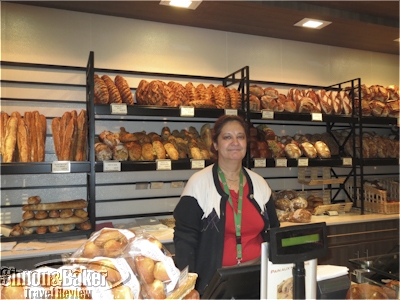
Dalida Gaoua, manager, at the Bercy Village shop

The back wall of the shop was well stocked to supply the steady flow of customers
Kayser began his career at the age of 19 when he went on a baking tour of France for five years. He was attracted, he says, by the bakers “hard working ethos, search for excellence and their ideal of fraternity.” He then taught at the National Bakery school (l’Institut National de la Boulangerie Pâtisserie,INBP) for almost a decade, traveling around France and the world, sharing his knowledge of French traditions.

Tiny round financiers in chocolate and regular were favorites

Tarts and pastries with fruit and chocolate were tempting
He helped many bakeries to open, and then decided to set up shop for himself. After our visit to the rue Monge bakery we discovered that it was his first shop, opened in 1996. Next time we are in Paris, we plan to return for our favorites and sample new products at one of the many Paris locations of Maison Kayser (http://www.maison-kayser.com/en/, contact@maison-kayser.com)
by Editor | Feb 11, 2013 | Food
By Elena del Valle
Photos by Gary Cox
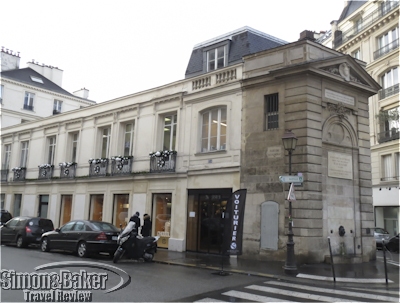
The shop and laboratory share space in this building
Jacques Genin loves chocolate. The self taught fondeur en chocolat, a chocolate maker who works with chocolate mixes (rather than raw cocoa beans), loves to make chocolates, candy and pastries, and eat them. We visited his spacious and modern shop in the Haute Marais neighborhood in Paris, France looking to answer two questions: What could make his shop special in a city riddled with chocolate and pastry shops? Would his products be so good as to draw us across town to the third arrondissement?
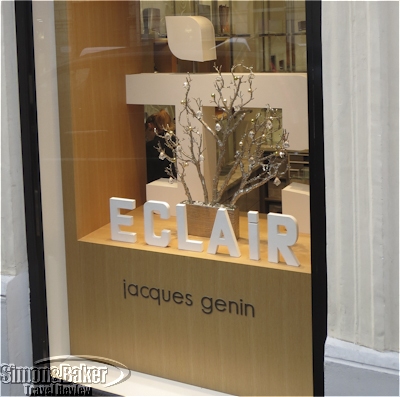
Each window featured one of the product lines
When we first approached the corner shop in a 17th-century double-fronted building we were surprised to see a voiturer or valet service at the entrance. Although we have seen valet service at many upscale shops and gourmet restaurants in Paris it was the first time we noticed one at a chocolate and candy shop. From the outside the window displays, even during the festive end of year season, were understated. As we entered the shop we were greeted by one of a half dozen staff members and directed to a table at the rear corner, behind a spiral staircase where a few minutes later we sampled hot beverages, chocolate and pates de fruit.
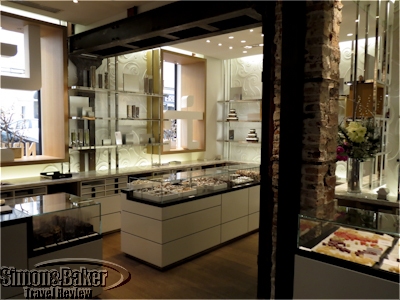
The public area on the ground floor of the shop was designed by Guillaume Leclercq
The busy shop, occupying the bottom part of a 400 square meter space, was uncluttered, organized and elegant. Designed by Guillaume Leclercq the public area featured exposed stone, steel beams and columns, red brick columns, panels of cream plasterwork, oak floors, polished stainless steel and a spiral staircase leading upstairs where the products were made fresh daily.
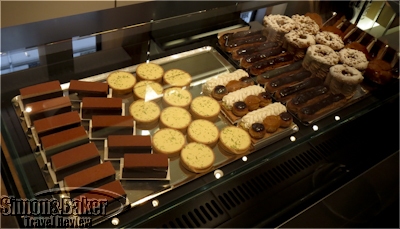
The pastries were made following traditional recipes (click to enlarge)
Friendly staff, some with gloved hands, assisted a steady flow of customers, many of them Japanese. We found out later that one third of the shop customers are from Japan. Near the entrance, there was a check-out counter where customers paid for their purchases after selecting their products at the section of their choice. A handful of steps led down to the main area with glass counters housing old style pastries (our chocolate eclair was delicious), caramels, chocolates, and nougats on the left. Pate de fruit, small sweet fruit paste cubes bursting with flavor, were in a stand alone counter in the middle. A selection of teas and coffee was available as well.
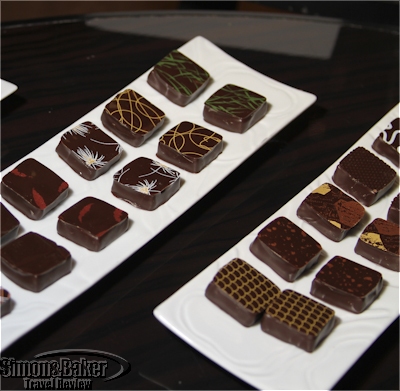
A selection of dark chocolates
So far so good, I thought. It wasn’t until, comfortably seated in leather armchairs next to the staircase, we sampled some of the fifty menu items that we understood what made Jacques Genin products noteworthy. Each bite size morsel had a flavor all its own, intense and unique. These flavors were worth a special effort.
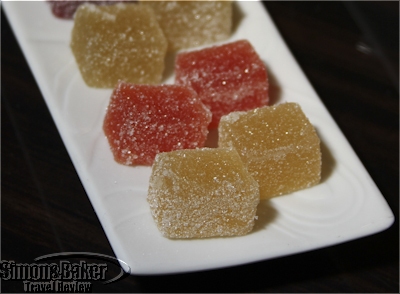
The pates de fruit were exceptional
The pates de fruit, available in nine flavors that day, were the best we have sampled. The flavor combinations, which vary with the season, were harmonious, sometimes unexpected. The ones we tried were were banana, black currant, blood orange, cherry, raspberry and rose, mango and passion fruit, rhubarb, pear and pineapple. To our surprise the pear flavor had a texture reminiscent of, well, pear.
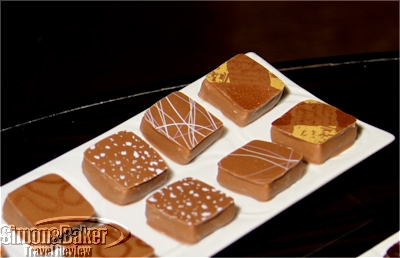
The milk chocolates
The chocolates, made fresh upstairs from 65 percent chocolate, were pretty with a strong distinctive taste. The fragrant ganache filling was well balanced and covered with an outer coat of chocolate, milk or dark. As soon as we bit into a chocolate piece the flavor popped. Moments later, the buttery chocolate joined the ganache in a perfect blend. While the dark chocolates, in the majority, were our favorites the milk chocolates were good as well.
Some of the dark chocolate varieties we sampled were: Mascarille made with Madagascar vanilla; Le beau tenebreux, just dark chocolate; Tonka teck, the tonka bean had an earthy taste; Sucre d’or made with chestnut honey; La belle epineuse with raspberry; Menthe amante (a favorite); Un grain with Szechuan pepper; Caravelle with mild spices; Rousse with cinnamon; C’est Noel with gingerbread; Bergame with bergamot; The toi with tea; Orangelique with orange; and Basilic instinct (a favorite).
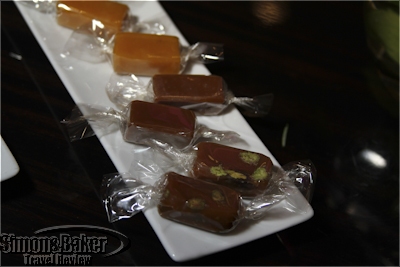
The caramels, like the chocolates and pates de fruit, were flavor filled
Jacques Genin products are natural and fresh, never frozen, the owner explained. To obtain the most natural flavors he prefers to infuse plants and spices. As a result the chocolates have a short shelf life. For example, our box of chocolates from December 18 expired January 3. We ate the chocolates past their expiration date, and while they were perfectly eatable and buttery the strong distinctive flavors we had loved at the shop had slowly faded.
Some of the chocolates and candy tasted familiar like the mango and passion fruit caramel. It was no wonder since Jacques Genin used to sell his products to two hundred hotels and gourmet restaurants before he opened the shop in 2009.
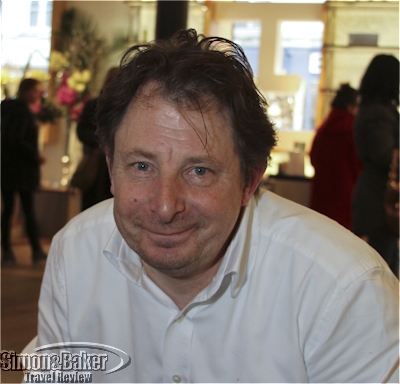
Jacques Genin was first drawn to chocolates for his daughter
As soon as he sat down to chat with us Jacques Genin, a reserved middle aged man who came alive when discussing his passion for chocolates and candy, began popping chocolates from our tasting tray into his mouth. When we asked which ones we should sample first and if there was a perfect order he smiled, reached for another chocolate and explained we should try them at random and simply enjoy them. When I wondered where the best chocolate came from he answered unequivocally, “Venezuela.”
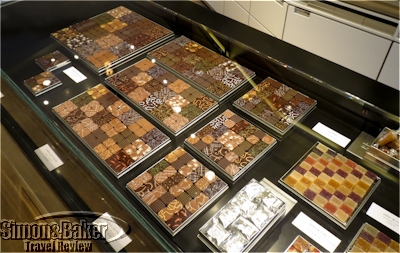
The chocolate and pates de fruit were sold in metal containers to keep them fresh (click to enlarge)
Genin, a chef originally, began making chocolates for his young daughter and over time the business took over his life. It was evident to us that he loved the products he made and looked forward to arriving at work every day, a man who worked for passion and pleasure rather than to make a living or only to make money. The payoff was in the fresh and uniquely flavored chocolates and candy we sampled. The answer to both of the questions we had on arrival was yes. Chocolaterie Jacque Genin (133 rue de Turenne, 75003 Paris, France +33 1 45 77 29 01, contact@jacquesgenin.fr) became a favorite stopping point in our gourmet wanderings in Paris.
by Editor | Oct 29, 2012 | Audio, Food, Restaurants and Food
Audio translation by Christine Lissac
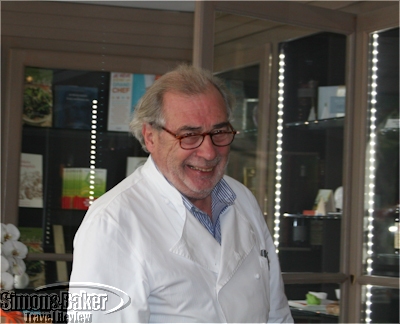
Chef Marc Meneau at Domaine de L’Espérance de Marc Meneau, his hotel and restaurant in Burgundy, France
Listen to a podcast audio interview, in French (see written English translation below), with Marc Meneau, executive chef, L’Espérance Marc Meneau. Earlier this year he discussed his restaurant, one of the best known gourmet French restaurants in Burgundy, and other culinary issues with Elena del Valle, host of the Simon & Baker Travel Review Podcast program, while she was at Domaine de L’Espérance de Marc Meneau in Burgundy, France.
To listen to the interview, click on the play button below
Interview translation:
EDV: So how do you cook?
MM: With love… I begin by reflecting a little bit on the manner in which I was fed in my childhood: with simple products. And I have always kept this traceability of a simple product, never sophisticated with six or seven different flavors in the same plate. I do not know how to do that.
I began to cook later in life after marrying a beautiful blonde whose parents were in the restaurant business and whose mother was a chef and so my wife coaxed me along that line. Eventually we began to consult cookbooks together. I was not a cook back then; we selected some recipes, some words, we did comprehensive research and it was with a document we wrote that we taught ourselves how to cook. And I am still learning, I have been for the past 45 years, I am a perpetual chef apprentice, therefore I observe with great attention all that happens around the world, draw my own conclusions, then continue on my own merry way.
EDV: What are you looking for when you cook? Why do you cook?
MM: Two things need respect. You need to respect the product: if you have carrots, once cooked they must smell like carrots, not smell like cumin or fennel; they must smell like carrots. The second thing is that cooking provides to the one who creates it, the opportunity to share what has been prepared, to present to someone the opportunity, the pleasure of eating well.
I believe these two things are of equal importance. Sometimes the product is more important, sometimes giving to others the pleasure to eat is more important. I have to admit that this inspires me to constantly come up with new recipes, invent new dishes. It is like walking along a little country road leading to Mount Olympus that I will never reach because my arms are too short.
EDV: How do you see this path of yours? The past and the future, as a French chef, what do you see?
MM: My motto is to only think about only 15 minutes into the past and to see the future over a period of a hundred years.
EDV: And what do you think about French Cuisine in the world?
MM: There was a time when French Cuisine was attacked at its very core about 10 years ago, though the one who invented a new form of French cuisine, Adria in Spain, was swallowed up and placed in the forefront in the U.S.A. where the American media thought they had found the world’s genius, without any second thoughts to the possible health consequences that this would have. Adria was a real genius but the public was too interested in “show” cuisines and the media overdid the idea to the point that it became only a Cuisine for Chefs, for those who have fun discovering new flavors, new textures, new technology.
It is not like cooking from memory; it is not like celebrating Grandma’s birthday or your child’s first communion. It is not family cooking; it is a “show” cuisine that was fabulously interesting for us chefs.
Certain French media took pleasure in thrashing out French Cuisine but it was clearly those that were less talented. French cuisine can exist without any problem next to Spanish cuisine, Italian cuisine, Vietnamese cuisine and Chinese cuisine. It is quite possible for all of us to live side by side as our cultures are very complementary to one another.
Each time a recipe exists, there is a story behind it, linked to the culture of each people, each civilization.
EDV: And when you think about what you are doing here in your restaurant, what do you see? Who is the person that is going to be satisfied having a meal here?
MM: This client must be a little like me. He must be someone who knows what a grain of salt and a grain of pepper are and he must also have a grain of imagination; this is how we are going to meet: the client at the table and me at the stove, giving someone an emotion that will become a memory in his life and remind him of his childhood. He could say “yes I have tasted carrots prepared this way with a similar taste twenty years ago.” Even if it is not exactly the same the important part is the memory retained at the time. This is how cuisine becomes a revealing mechanism of life’s emotions.
EDV: Does that person need to be French?
For millennia now cooking has become an international thing, it does not have a country, a color, it is only the expression of how people live on a particular territory. Life is lived differently whether you live in Africa, Asia Minor or Northern Europe. Therefore each country will have its own traditions.
Here is a simple example: Meat can be grilled using old vine logs or pine wood from the moor, birch wood from the northern country and all these will produce a different flavor. There is going to be identification by methodology that will create a different taste.
EDV: So how do you know how to choose this or that place?
MM: Well that is a choice to be made.
EDV: So we ask advice from the chef. What is the style that you produce in your kitchen?
MM: In order to give advice one has to know the people asking for it. The first time you meet them it is impossible to know them. Therefore one must have clients that become patrons so that after their third visit, their host knows that they like eating ris de veau or prefer a turbot fish to a lobster. All that forms part of the professional experience of those working in the restaurant’s dining room. This is no longer the work of the chef. The chef cooks the type of cuisine that he likes and if some people like his type of cuisine, it is all the better. If some people do not like his cuisine, well then either he commits suicide as Vatel did or he changes his range.
EDV: Would you say that this is Classical French Cuisine?
MM: It is the cuisine of Marc Meneau
EDV: Is it not possible to describe it?
MM: No. Not possible.
It is neither classic nor modern; it is the way people like to eat these days while experiencing an emotion. Whether they only want to eat one dish, prefer to eat quickly; there are appropriate dishes for them to choose, and if they would like to have a feast there are also dishes appropriate for that, if they wish to spend an enjoyable evening, between friends or as a couple, there are dishes suitable for that too. No rules.
EDV: The products – Because we begin with the products – what can you tell me about them?
MM: Without product there is no cooking, one does not need to be a good cook if one has rubbish products. One must only use the best products: good products draw out the chef’s intelligence because once the chef has the notion of the effort required to produce these good products and the respect they deserve he will not cheat with them.
EDV: How do you go about getting good products?
MM: We have a lot of experience in this profession and we personally travel across France ten times a year looking for products.
EDV: And what is available here?
MM: Here we have a countryside blessed by the gods as far as architecture, literature, music, history is concerned yet we have rather humble products with the exception of meat, the Charolais (bovine) and of the river fish, which people do not eat anymore, they don’t like it; these days, people do not eat river fish anymore for a single reason: fish bones, sea fish have less bones.
So, as far as foie gras is concerned, we don’t have any here, we only have ham, we have mushrooms. We are limited in what we have but on the other hand we have fresh herbs every day and condiments of good quality. So we find ham in Spain, foie gras either in Landes or in Alsace. We find poultry in Bresse.
EDV: And this morning you took me to visit… the vegetable garden. So what can you tell me about the vegetable garden?
MM: The vegetable garden is a virtual calendar developing in my head; and when I see the first radishes coming through, the leeks, the first lettuces, the zucchini, the eggplant, the tomatoes. Walking through the vegetable garden every day gives me ideas and inspires me to cook. It is a trigger for ideas and inspirations and at the same time it positions me within the right season, so I almost become an honest man.
EDV: And so you have to work hard to get the products from your place? I believe you have two employees in the garden?
MM: Yes, two employees take care of the garden to allow us to have a beautiful garden with flowers, agreeable and simple without sophistication, and a vegetable garden which will bring back to the minds of those strolling by, memories of their grandmothers, their parents, prompt that get them to recall visits to some beautiful castles. Most importantly, they will begin to think to themselves: “rather than having caviar for lunch I am going to have some of these good old radishes with fresh farm butter,” radishes that would never have seen the inside of a fridge, that would not have been transported by truck and that would have been picked that same morning. That is true luxury.
EDV: Do people appreciate it? Do they realize that when they come and sit at your table?
MM: Yes, we are in a period where people are in the process of rediscovering vegetable gardens and leisure gardens and I encourage everyone who has a little balcony or window to plant a few things there. I think it is awesome … because we know we have a rotation over about 20, 40 days in a year, one can have fun by planting a few lettuces, a few carrots, a few radishes, and the day that you are going to eat your own vegetables, it is going to trigger an explosion of joy which will get you to think “I know why I am human, I know why I live.” My dog is unaware of this.
EDV: This is only available to humans…
MM: To mankind… the privilege of humanity is to have the sense of taste, not intelligence, taste. I don’t think other animals have a sense of taste. We do, we have a sense of taste.
EDV: What is the biggest challenge for you, and for a chef today?
MM: It is to stand firm against all the commercial offers of bad products. Recently a great French label of nutritional products, offered with a lot of colorful pages, some truffles all chopped up with gold leafs mixed in, saying that it would make a dish of risotto or rice “chic” when adding this very expensive product that is actually useless. Either we have truffles or we have gold. Gold is for festivities but it is not nutritious. So one has to resist the pressure of the clients who want to pay less and less for their food because they have so many other financial commitments that did not exist twenty or thirty years ago, but they are all so trendy, to the point that these days the cost of food for consumption is lower. So it is up to us chefs to find a solution to reduce the cost but not at the expense of quality, rather by stimulating our creativity and knowledge and harmonizing them in a recipe that could be very simple as long as it is made with good old products. Flashy components are no longer necessary as they used to be in the eighties and nineties, where one had to eat lobster, caviar, foie gras, etc. That era is over. If we do caviar now it will be an eggplant caviar, no longer the caviar from the sturgeon.
EDV: Why?
MM: Because it is no longer in fashion! The price is not justifiable. Twenty or thirty years ago, the cuisine was … how could I say…a social entertainment, today it is an introspective entertainment: how am I going to eat well, how am I going to avoid processed food that we don’t really know much about like how it is produced. How am I going to manage that? How much time can I invest in my cooking in order to avoid the bland ready-made meals with their standardized taste? There are colorants, artificial sugars in each processed product. People are beginning to discover that when a product is natural it is a little less like Coca Cola.
Because when we have a glass of Coca Cola we need a second one. Where as if we drink an ice tea for instance, it is not necessary to have a second one. This is the difference and therefore the cuisine is going to become like that, an element of cultural sobriety.
EDV: Do you think it’s going to be like that in the near future in five or ten years?
MM: Yes I think so. There will always be …. and this is specific to France…upstream from the chef, people that are producing exceptional products. Those that farm and breed are contributing to the greatest wealth of our culinary capital. Today I believe that carrots or tomatoes farmed through extensive agricultural methods are going to lose ground, they will be less and less chosen for cooking.
EDV: What do you mean by extensive agricultural methods?
MM: It is producing farm products in very large quantity using fertilizers. And I think that we are going to return to the original way of farming fresh products.
EDV: I see, cheaper in higher quantity…
MM: Yes that’s it… because a very big tomato cost one euro and three average size tomatoes cost one euro, and when you eat a big tomato from the garden it is more than enough to satisfy your hunger. You would need three badly cultivated tomatoes to make up for that and you spend the same amount of money.
EDV: Are young people able to recognize that?
MM: Young people educated in that discipline can. As for those who are not… I don’t know what we are going to do with them. I would advise parents to set aside one hour per week cooking for their children, to rediscover life around the table and discussions around a meal where one would say “I bought these potatoes last week while we were away at such and such place…” and they will know they are eating those particular potatoes. So, to have gone out to buy the potatoes, brought them home and stored them in the best possible way until the time comes to peel them and cook them, this calls for respect and those potatoes will not be eaten in the same manner that those purchased from the greengrocer downstairs, or in town, that’s if we cook them in water…if they have not been bought already prepared.
So I believe that people have to return to the way things were. In the eighties, some architect designed kitchens that look like lounges. We need to go back to the homely kitchen.
EDV: Some people say that chefs are artists…
MM: Yes I think so, in a conceptual manner. In the realization of our trade we are artisans and in the conceptual dimension of the research it requires… yes… because we work a little bit like musicians would. They have their musical chords and we have our taste buds chords: sour, sweet, salty, bitter and spicy; with five flavors we make millions and millions of recipes!
EDV: And it is also a visual experience, not only the blending of flavors but you also look after the appearance of your dishes.
MM: Well, nature has provided for us the colors red, yellow, green… blue does not work in food, black, with the exception of truffle and caviar, does not work either. Therefore the color scheme for food remain within primary colors… it is between green, white, red and yellow and that’s where its stops.
EDV: Has the presentation evolved?
MM: Ah yes, presentation has evolved in as much as the portions have become smaller, sauces that were hiding the flavor of food have been removed and replaced by lighter gravies and spices that accompany a dish and they too have become a lot lighter. In forty years, I have witnessed a great evolution, it has been exceptional and with the knowledge I have of France I can say that we have never eaten as well as we do now, never before.
EDV: Recently some people have told me that there were more three-stars restaurants in Japan that in France. Should French restaurants overseas be evaluated in the same manner as French restaurants in France? What is your take on that?
MM: I shall not answer this type of question. Some imbeciles believed that it was better to attribute distinctions outside of the country. It is their choice not mine.
EDV: But the question is: can one eat French cuisine outside of France?
MM: No! The products are not the same. It is heresy. When I see the number of three-star French restaurants in Japan, I say …. pfff! Really, I think those that live in France are truly imbeciles…either that or they do not know the director.
EDV: I also wonder about something else…when I see the work required to own a restaurant, particularly for those that do not form part of a big organization with a lot of money, for those that are independent owners, if you do not have talent, if you do not do a great job… you won’t make it.
MM: Yes, it’s the end for them. There are two types in our line of work that operate at two different paces. There are the great investors and the simple owners like us, those that operate with their heart, their faith and the many number of working hours they invest in it.
EDV: So then I wonder about the next generation… Will they be able to do what you have done? Will they have the spirit to create something out of nothing as you have done with your restaurant? What is your opinion?
MM: So this is a good question, but not one that a man of my age can answer. I can only comment a little about it: the children that have been brought up witnessing all the benefits and all the down sides of our profession will maybe keep in mind the benefits. For instance those benefits will be to be able to go to the Bernardins or Chez Goulue and always have a table ready there even without booking it and not having to pay for it. That is the respect that chefs have between each other. Another benefit is to go somewhere and receive a medal. That makes us proud because after all we are “dramatic” people. After spending 15 hours a day in our business, sometime we love an hour during which we can enjoy being the little king of the moment. I have no problem with that. No, I believe it is human nature that causes even a child or another chef to be interested in this kind of benefit. Those unfamiliar with this sort of thing who have access to the position via cooking, want to imitate their chef. It’s what we call motivation. It’s what we call in French la niaque which means to be strong and determined, with a lot of will power. That person says to himself, “I will do it this way, I will succeed,” and he will in time as his era allows him to. There will always be people with ambition and passion.
EDV: Do you think so?
MM: Yes I do.
EDV: So then there is hope?
MM: Well yes … If we had lived like they did in Russia forty years ago, we would not have had the opportunity to have ambition. But we still live in countries where ambition is not a sin.
EDV: Thank you very much then.
by Editor | Jun 13, 2011 | Accomodations, Food
Article and photos by Elena del Valle
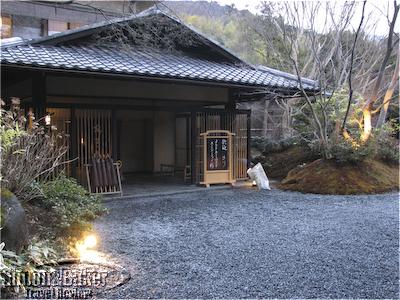
Entrance to the Ryokan Yagyu-No-Sho
Earlier this year when I was in Japan I visited Izu, an area of the country known for its hot springs. The highlight of my stay was spending the night in a luxury ryokan, a traditional Japanese hotel. My brief visit was especially rewarding and memorable for the experience itself as well as the many luxury features the ryokan offered. While the property catered mostly to Japanese customers it was part of a national alliance of luxury ryokans that facilitated bookings by international travelers.
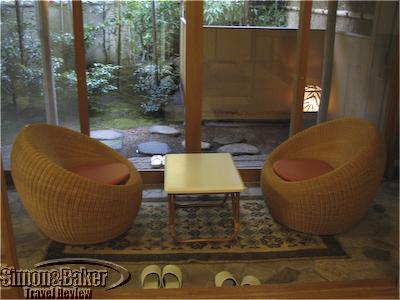
Looking out at my corner garden
In spite of steep linguistic challenges I felt welcome and would be pleased to return for a longer stay. Some of the characteristics of the ryokan I enjoyed the most were the traditional style of the facilities with flower arrangements (made by one of the owners) and artwork, manicured gardens with water features, friendly and service oriented staff, hot spring related offerings and delicious gourmet meals. There was excellent and fast complimentary WiFi connectivity in my suite, an amenity I greatly appreciated.
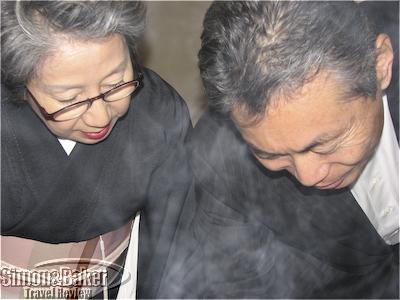
The ryokan owners preparing a meal
Yagyu-No-Sho, a traditional style ryokan with modern conveniences in the heart of a village, was owned and managed by Takashi Hasegawa and his wife. In the entrance foyer, my eyes were drawn to the wall wide bamboo forest with small birds, a beautiful artwork made of wood panels painted by a Japanese artist in her 90s who is well liked by the imperial family. In her painting, one of the staff explained, she uses only natural materials. The green in the painting was from oxidized copper and the white was from a stone.
On arriving at the ryokan we were invited to remove our shoes and wear a pair of house slippers (this was rather uncomfortable because the slippers they provided were several sizes larger than my feet and made it necessary for me to walk slowly to avoid tripping). I shed my slippers to enter my room which was covered wall to wall with tatami mats.

Artwork on wood panels with natural materials
My second floor room, Harvest, had a private bathroom with a separate section that housed a wood tub filled with hot springs water. The room, divided into several areas by thin paper and wood walls, was pretty and spacious. The décor was in a traditional Japanese style furnished with simple floor level chairs and tables. Instead of a bed the staff set up a sleeping area, at the end of the day, with futons, duvet blankets and feather pillows that were kept in a closet during the day. I slept very well in the comfortable floor level futon. There was a small indoor patio with Western style chairs and a table next to the room where my sleeping area was set up. Next to the patio there was an outdoor area that could be reached, while wearing special outdoor slippers, via sliding glass doors.
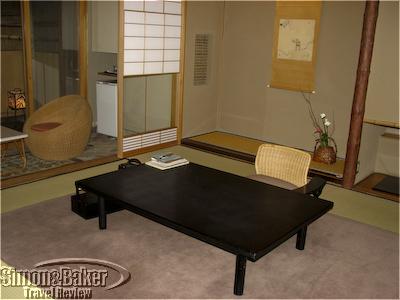
Ryokan room with traditional furnishings
The room had a living area with a low table and one cushioned armless low chair. A recessed area was home to a flower arrangement. There was also a sitting area with a low table and two chairs. Under the table there was space to rest my feet on the warm floor. To one side stood a small vanity with a mirror, tissue paper, and a cushion.
The bathroom was divided into three separate rooms. One housed a water closet with an automated Japanese heated toilet and and a mini wood sink. There was a wide room with a sink; next to it was the bath tub room which had just enough space for a large wood bath tub and a small shower area placed against the wall. The shower corner, low to the ground, consisted of a small wood stool and a handheld hose to shower thoroughly before dipping in the hot water of the tub.

Ryokan staff in traditional dress
The temperature within the room was comfortable for me. It was controlled with a remote control. Amenities, set inside a cloth bag on the tatami floor, were: a set of Japanese pajamas, shower cap, toothbrush, hairbrush, cotton pad, cotton swabs, and hair scrunchy. There was a mini refrigerator next to the coat closet.
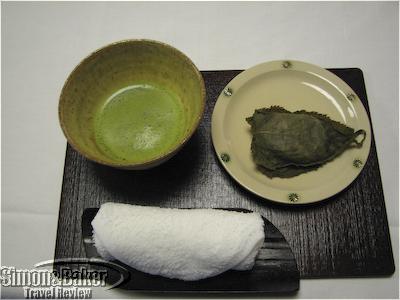
Excellent green tea
Dinner, served at 6 p.m. sharp consisted of 12 generous courses of Japanese dishes. Although it would usually have been served in individual rooms, the ryokan staff set up group seating for the six of us in one of their large rooms. To keep our hands clean we were provided with three wet towels during the course of the meal. The service began with a taste of unfermented sake as an aperitif. Meals, clearly, were an important part of the experience at this ryokan. There was a pretty dinnerware service with different dishes for the varied courses. Three ladies looked after us and served us copious quantities of delicious food.
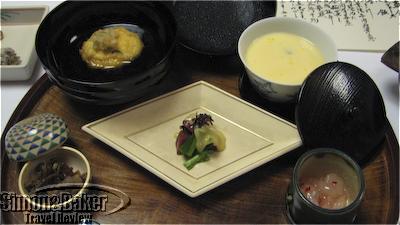
The food was attractively served and delicious
Breakfast the next morning was equally well served and as satisfying. We had rice; pickled vegetables; miso soup; beef, shiitake mushrooms and long onion cooked with a large leaf over charcoal; boiled sliced beef with a sweet soy sauce; tuna and long onion with vinegar miso; salted and fermented squid innards; deep fried tofu burger; dried fish; egg custard; sweet red bean soup with rice cake; and sherbert.
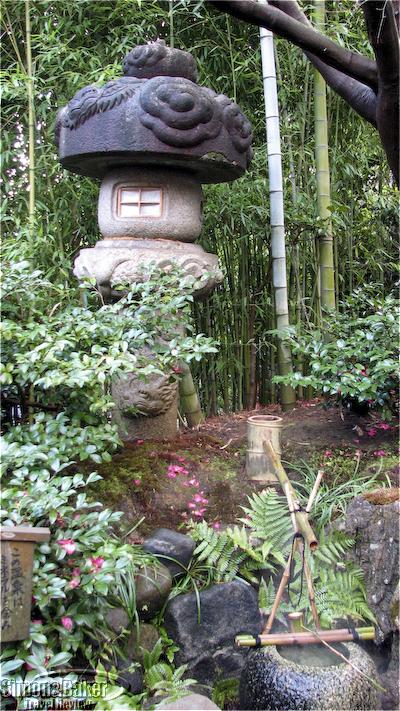
Tranquil gardens
If the opportunity presents itself I would gladly return to Yagyu-No-Sho. Next time I would request one of the ryokan’s ground floor luxury suites with indoor water features where some of my travel companions stayed. Yagyu-No-Sho, 1116-6, Shuzenji, Izu-City, Shizuoka-Prefecture, Japan, +81558724126, Fax +81558725212, http://www.yagyu-no-sho.com
by Editor | Mar 28, 2011 | Food
By Elena del Valle
Photos by Gary Cox
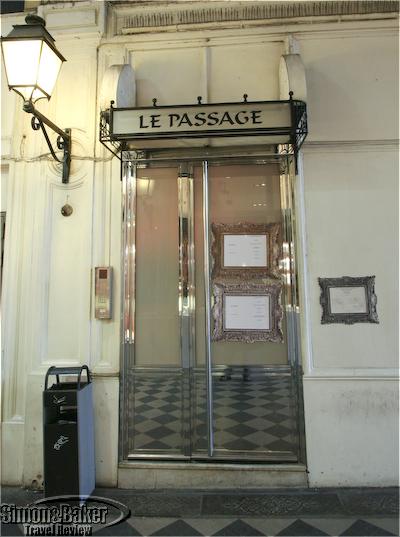
For years we dined at Lucas Carton, a well known gourmet restaurant, whenever we visited Paris, France. Then one year Alain Senderens, the chef and restaurant owner, converted the restaurant into a bistro; modernized the look and style, changed the menu and reopened under his name, Senderens. We had dined several times at Senderens when we heard that there was a new bar area upstairs that served a limited menu including a set lunch menu.
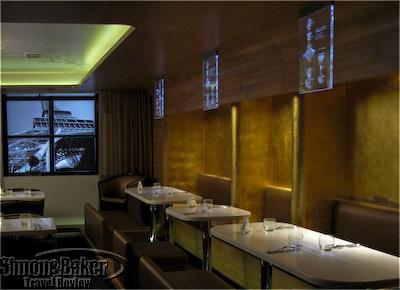
The main seating area at Bar Le Passage
Twice during a recent winter visit to Paris we had an opportunity to sample the food options at Bar Le Passage. The first time we requested a table upstairs at Bar Le Passage one day in advance. Because the few tables were already reserved we accepted two seats at the bar. Although the bar stools were rather uncomfortable, the room was pleasant, furnished simply with elegant touches, the bar tender was service oriented and spoke some English and, most importantly, our lunch was delicious.
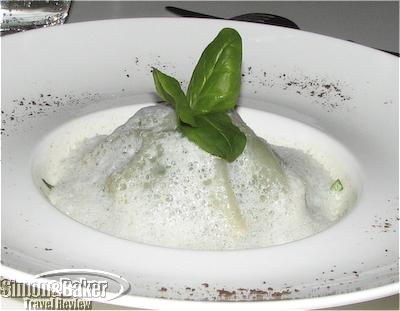
The vanilla lobster
We began with a glass of non vintage Pommery Champagne then ordered one three course set menu (35 euros) which that day was a cold Game Pie, Codfish a La Plancha, and an ice cream and fruit combo as well as a Vanilla lobster (25 euros). An amouse bouche arrived before our order and there was also a plate of bread. For dessert, we recognized and old favorite from the days of Lucas Carton, the Samana chocolate plate (half a portion) with candied cherries (10 euros).
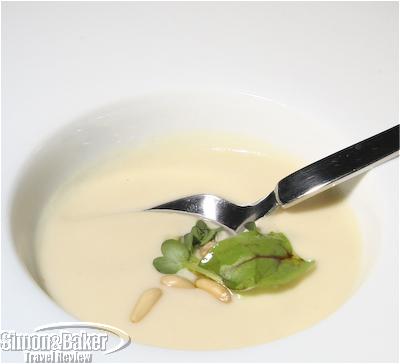
The amouse bouche was soup garnished with pine nuts and herbs
The next time we reserved a table at Bar Le Passage several days in advance. We were running a few minutes late and I called to make sure they would hold our table but I was on hold so long the answering system cut the call. Although we arrived a few minutes late our reservation was still valid. We had two tables to choose from and picked one of the two tables next to the bar itself. We could have chosen to sit at a table in the center of the main seating area of the bar as well.
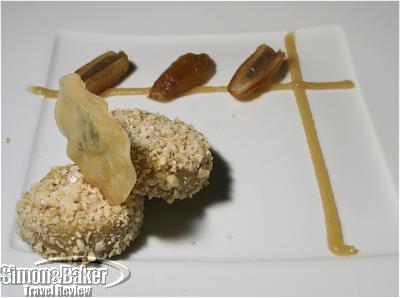
Pistachio encrusted foie gras
This time we tried the foie gras which was pistachio encrusted and served with stuffed dried figs and a lemon sauce. Once again we ordered the Vanilla lobster and Samaná dessert.
Both meals were tasty and satisfying. The service was attentive and the setting was attractive. We will keep Bar Le Passage at Senderens on our list of options for a quick gourmet bite in the City of Lights, especially if we are in the Place de la Madeleine and its environs. Bar Le Passage, 9, Place de la Madeleine, 75009, telephone +33 1 42 65 56 66, fax +33 1 42 65 06 23, email restaurant@senderens.fr.

Samaná with candied cherries




















































